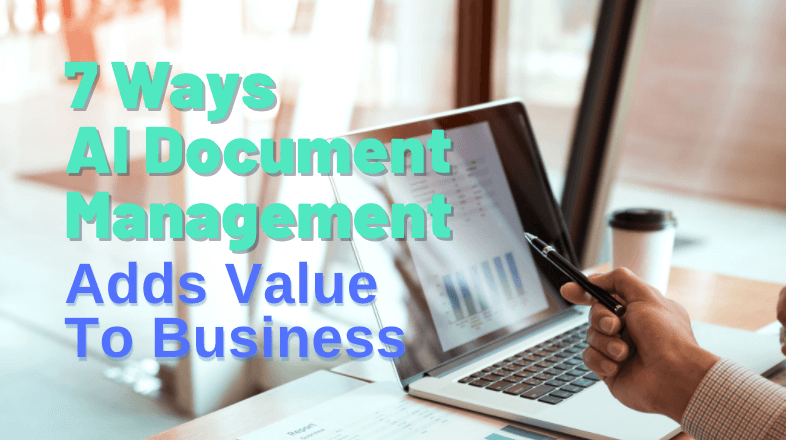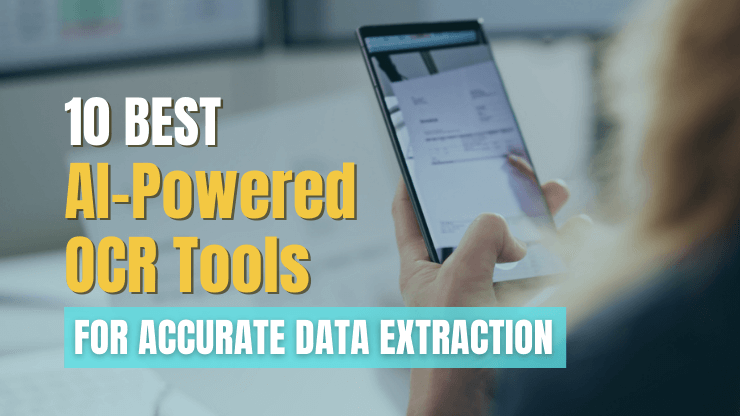The global volume of data is growing at an annual rate of 19%. As this expansion continues, businesses face increasing pressure to manage and utilize their data efficiently. This is where AI document management comes into play, significantly improving the way organizations handle and optimize their essential business data stored in documents.
By automating tasks such as capturing, organizing, and analyzing documents, AI not only improves efficiency and accuracy but can also enhance decision-making and compliance. In this article, we'll explore what AI document management is, why businesses are investing in it, and highlight seven key use cases that can boost productivity and transform your own business processes.
What is AI document management?
AI document management refers to the application of artificial intelligence technologies to streamline the management of documents within an organization. This involves using AI-driven tools and techniques such as machine learning (ML), natural language processing (NLP), and optical character recognition (OCR) to automate the processes of capturing, organizing, indexing, retrieving, and analyzing documents.
By leveraging these advanced capabilities, AI-powered document processing systems can efficiently handle large volumes of data, improve accuracy, enhance searchability, and ensure compliance with regulatory requirements, all while reducing the need for manual intervention.
Key drivers of AI document management adoption
Businesses are increasingly investing in AI document management for many of the same reasons that we’re seeing a broad investment in AI technology in general. With AI document management solutions, businesses are seeing:
- Enhanced efficiency and productivity: AI automates repetitive document-related tasks, reducing human errors, enabling employees to focus on higher-value activities. For example, Beam AI reports a healthcare provider achieved a 60% reduction in manual labor after embracing AI document automation.
- Cost savings: Reducing manual data entry can also translate into substantial cost reductions. Google estimates major public sector agencies can save $1-2M over 5 years when they automate the processing of just one of their forms.
- Improved accuracy and compliance: AI minimizes errors and ensures consistent adherence to regulatory standards, reducing the risk of compliance issues.
- Better decision-making: By turning unstructured data contained in documents into searchable, archivable structured data, businesses can more easily access actionable insights from document data.
7 ways AI document management adds value to business
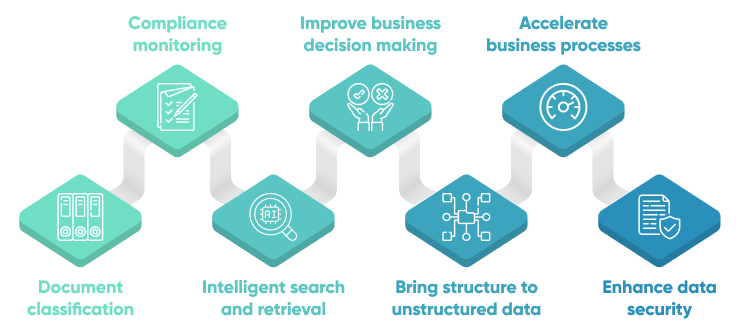
AI document management serves as an overarching term for many more specific use cases. In this section, we’ll look at 7 of the most common use cases, all of which can help you to streamline document management and improve document handling across your business processes. Let’s get started.
Document classification
Document classification leverages advanced algorithms to automatically categorize documents based on their content. This process involves analyzing the text, structure, and metadata of documents to assign them to predefined categories, enabling efficient organization and retrieval.
As these systems continuously learn from the data they process, their accuracy and adaptability improve over time. This automated classification not only accelerates intelligent document management but also ensures consistency and precision, which are vital for maintaining data integrity and regulatory compliance.
Example tools:
- Form KiQ: Document layer API-first options powered by AWS and AI available as both headless and web-based software that offers flexibility to customize and build a custom solution.
- Alphamoon: Offers a document classification feature that leverages AI to automatically categorize documents based on their content.
- Super.ai: Uses machine learning to accurately classify documents into predefined categories.
- SER Group: Has a document classification feature that helps in sorting and routing incoming documents to the appropriate departments or systems, specifically designed to handle large volumes of mail.
- Snorkel: Provides a document classification solution that utilizes weak supervision techniques to train machine learning models with limited labeled data.
Case study:
As one of Germany's largest property and liability insurance providers, DEVK insures against 13 million types of perils, generating a vast number of documents such as applications, policies, and claims. To ensure fast service, these documents need to be digitally processed and classified from the outset.
To achieve this, they transitioned to early scanning and digital document management in case processing. However, their legacy archive was inadequate, lacking a case-centric document management system (DMS) with automation-ready processes. As a result, DEVK decided to replace the outdated archive and DMS software with Doxis4 from SER Group, which aids in the classification of scanned documents along with other more advanced document management features.
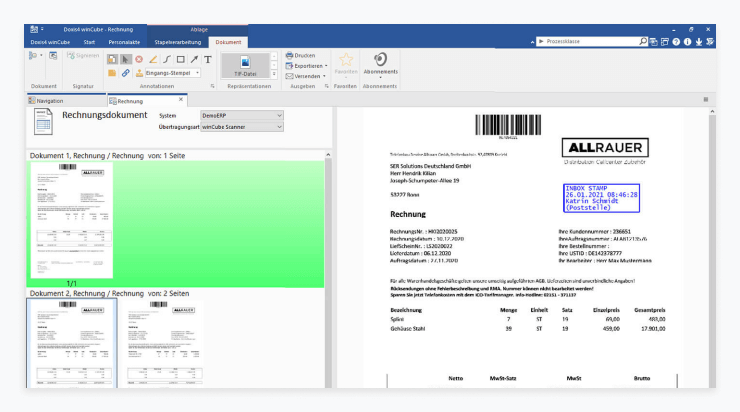
Compliance monitoring
By leveraging advanced AI technologies, organizations can significantly enhance their compliance efforts. These advanced systems can analyze data, detect anomalies, flag potential compliance issues in real-time, and provide comprehensive audit trails, thus reducing the risk of non-compliance and associated penalties. This automation shifts compliance teams' focus from repetitive manual activities to more strategic tasks.
These AI-driven capabilities transform compliance management, enabling organizations to achieve:
- Real-time anomaly detection: Identifies and flags potential compliance issues promptly, allowing for swift resolution.
- Comprehensive audit trails: Maintains detailed records of document access and changes, facilitating easier compliance audits.
- Regulatory requirement tracking: Keeps track of evolving regulations and ensures all documents adhere to the latest standards.
Example tools:
- Shinydocs: Uses AI to continuously identify and report privacy risks across content systems, helping organizations safeguard PII and meet regulatory requirements.
- Vanta: Automates compliance monitoring for standards like SOC 2, HIPAA, and GDPR, integrating with over 300 tools to provide continuous security and compliance automation.
- super.AI: Provides IDP that includes compliance monitoring, using AI to ensure contract terms and other documents comply with legal standards and industry regulations.
- Box: Integrates AI to enhance document management and compliance monitoring with advanced security features, real-time alerts, and compliance with various regulations.
Case study:
USAA, one of the largest financial services companies, faced challenges with productivity and compliance due to cumbersome document processing workflows and strict regulatory requirements. By integrating Box Governance, USAA ensured compliance across all lines of business, with features like retention policies and security controls.
This system not only facilitates seamless access to necessary data from any device but also provides a comprehensive audit trail for regulators and auditors. The move to Box's digital document management significantly streamlined workflows, reduced manual tasks, and enhanced regulatory adherence, enabling USAA to focus on innovation while maintaining stringent compliance standards.
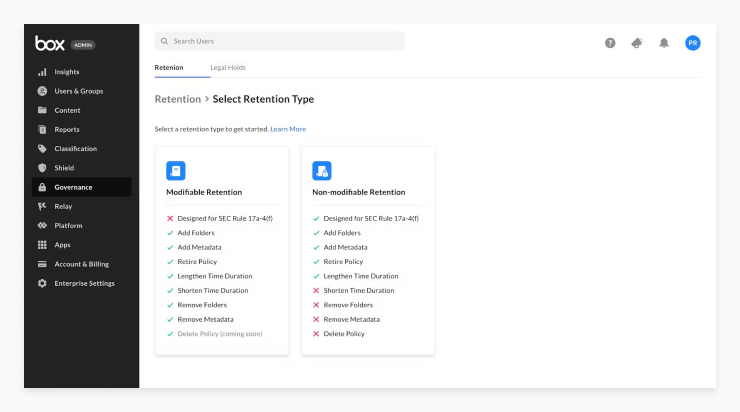
Intelligent search and retrieval
Intelligent search and retrieval tools utilize advanced algorithms and NLP to quickly index and understand the context of vast amounts of data, enabling users to locate relevant documents and information with unprecedented speed and accuracy. This capability reduces the time employees spend searching for information, allowing them to focus on more critical tasks, thereby boosting overall productivity.
Some examples of teams that are making use of AI-powered search and retrieval include:
- Legal teams: Quickly find relevant case laws, precedents, and regulatory documents needed for building strong legal arguments and ensuring compliance.
- Customer support: Instantly access customer history and relevant troubleshooting documents to resolve issues more efficiently and improve customer satisfaction.
- Research and development: Effortlessly locate prior research, patents, and technical documents to streamline the innovation process and avoid redundant efforts.
- Sales and marketing: Retrieve pertinent sales reports, customer data, and market research to craft compelling pitches and strategies, leading to increased sales effectiveness.
- Human resources: Efficiently access employee records, training materials, and policy documents, enhancing the ability to manage talent and ensure regulatory compliance.
Example tools:
- SER Group: Enables intelligent search and retrieval by capturing, organizing, and understanding documents.
- Paxton: Revolutionizes legal research by using AI to track the standing and precedential value of case law.
- Shinydocs: Uses AI and automation to analyze and classify files, enabling efficient search and retrieval across various content repositories.
- Box: AI-powered content management platform that simplifies collaboration and workflow automation via its intelligent search capabilities.
Case study:
The Dunedin City Council (DCC) in New Zealand sought to enhance their digital records management to improve employee experience and compliance. By partnering with Shinydocs, DCC implemented a comprehensive suite of solutions, including Enterprise Search, Cognitive Suite, and Shiny Visualizer. This transformation enabled DCC to scan, tag, and score all repositories and documents, making information readily accessible through intuitive dashboards.
As a result, DCC employees now enjoy unparalleled search capabilities, saving 6,500 productivity hours per week and reducing storage costs by 35%. This intelligent search and retrieval system ensures faster, more efficient citizen services while maintaining stringent compliance and security standards.

Improve business decision making
AI document management tools have revolutionized the way businesses handle information, significantly enhancing decision-making processes. By enabling swift retrieval of relevant documents, these tools empower knowledge workers to make informed decisions quickly. For example:
- Reduced IT support requests: Decreases the frequency of document search-related support requests, allowing IT departments to focus on strategic tasks.
- Real-time operational insights: Provides executives with up-to-date insights into operational and market trends for proactive decision-making.
- Enhanced financial forecasting: Assists financial analysts in deriving insights to improve forecasting and financial planning.
- Improved talent management: Enables HR departments to utilize insights from document management systems to enhance talent management and recruitment strategies.
Example tools:
- Klippa DocHorizon: Offers AI-powered document processing, automating tasks such as data extraction and document classification.
- M-Files: Revolutionizes knowledge work by automating document-centric workflows and enhancing process efficiency.
- Google Cloud Document AI: Uses generative AI to extract, classify, and split documents, transforming unstructured data into structured insights.
Case study:
Pennylane, a rapidly growing financial management platform for small and medium-sized businesses, integrated Klippa DocHorizon to enhance their data extraction and processing capabilities. By utilizing Klippa’s OCR technology, Pennylane automated the extraction of financial data from various document formats, significantly reducing manual effort and improving data accuracy.
This integration allowed Pennylane to efficiently manage invoices and bank transactions, providing real-time access to reliable financial data. As a result, Pennylane improved decision-making processes, enabling business owners and accountants to focus on more strategic activities, thereby maintaining a competitive edge in the market.
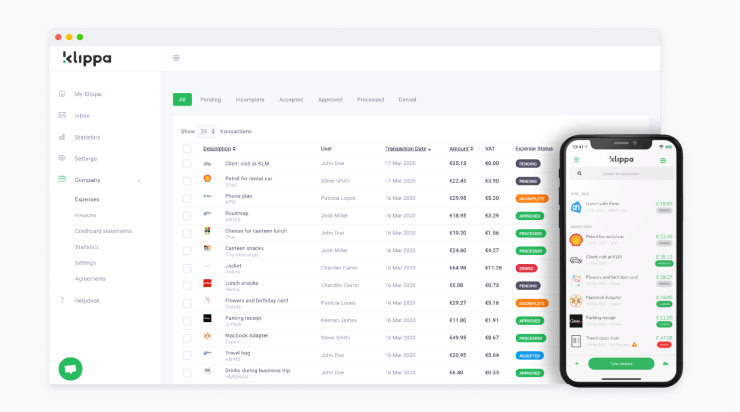
Bring structure to unstructured data
Unstructured data, which includes emails, files, PDFs, and documents, constitutes about 80% of an organization's data, according to Gartner analysts. Traditionally, extracting and organizing this data required manual effort, often involving spreadsheets. AI document processing transforms this landscape by bringing structure to unstructured data, enhancing its accessibility and usability.
Technologies like NLP, ML, and OCR can improve document processing workflow, converting text-heavy documents, such as reports and customer feedback, into structured, searchable, and analyzable formats. This process not only makes data more manageable but also significantly improves its utility across various organizational functions.
Example tools:
- SER Group (Doxis DMS): AI-powered document management system that digitizes, processes, and organizes documents, transforming unstructured data into structured formats
- Klippa DocHorizon: An intelligent document processing platform that uses AI to automate the extraction and structuring of data from various document types.
- Docsumo: Leverages AI to extract, validate, and structure data from unstructured documents with high accuracy.
Case study:
Stratify Solutions, a US-based tech consulting company, needed a contract management lifecycle software to streamline various contract workflows, including creation, renewal, negotiation, and approval. Partnering with SoftKraft, they implemented an AI-driven OCR and document management solution to handle complex service terms from multiple suppliers.
This system transformed unstructured data from PDF documents into structured data records stored in a relational database, dynamically learning document specifications over time. The new contract management software centralized and secured document management, improved contract process control and visibility, and enhanced key contract terms' accessibility, such as renewal dates, while automating alerts for business users.
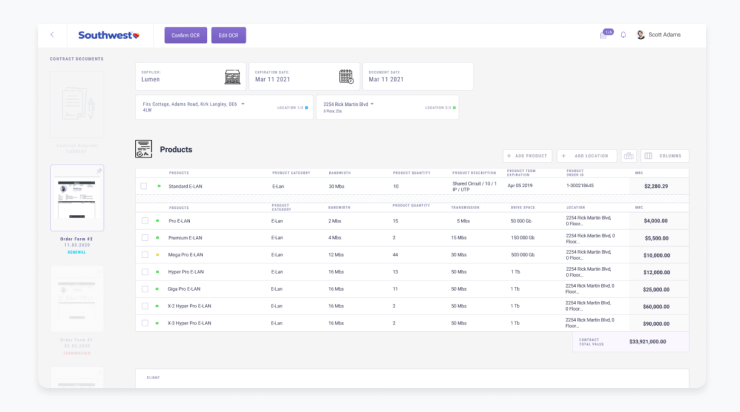
Accelerate business processes
AI document management systems can significantly accelerate business processes by automating routine tasks, enabling efficient document retrieval, and enhancing workflow efficiency. Virtually any business process that involves document processing could be improved with AI. Let’s look at some examples of business processes that could be accelerated with AI document processing solutions:
- Invoice processing: Automates the extraction of invoice data and integrates it into accounting systems, reducing processing time and minimizing errors.
- Contract management: Quickly analyzes and retrieves contract clauses and key terms, facilitating faster contract review and approval processes.
- Customer onboarding: Automates the verification and processing of customer documents, speeding up onboarding times and enhancing the customer experience.
- Compliance reporting: Streamlines the collection and organization of necessary documentation for regulatory compliance, ensuring timely and accurate reporting.
- HR processes: Automates resume screening and employee record management, reducing the time spent on hiring and administrative tasks.
Example AI tools:
- Klippa: Uses AI to automate document workflows, significantly reducing processing times required to extract data, classify, and verify it.
- Docugami: Applies AI to transform unstructured documents into structured data, enabling businesses to automate document management processes.
- DocuPhase: Offers AI-driven automation solutions for document management, including intelligent data capture and workflow automation.
Case study:
JetBlue, the sixth largest airline in North America, serves over 40 million passengers annually for domestic and international travel. Managing over 51,000 invoices monthly across 4,000 approvers and 10,000 suppliers, JetBlue sought to streamline their complex accounts payable processes.
By implementing DocuPhase AP automation solution, they achieved nearly 90% straight-through and touchless invoice processing, significantly reducing the need for manual intervention. This AI-driven automation accelerated their business processes, lightened the workload of internal staff, and enhanced overall operational efficiency.
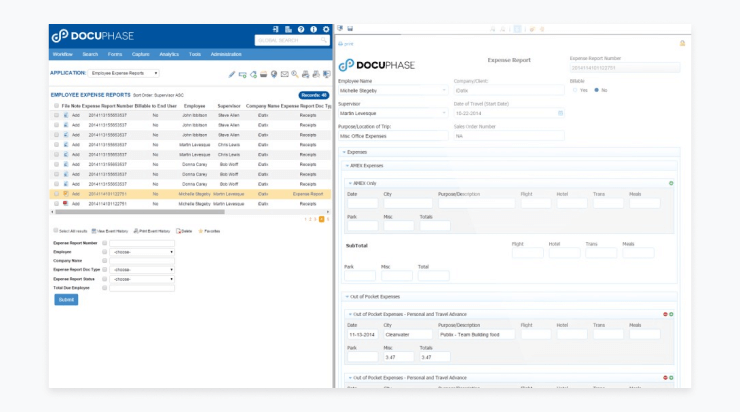
Enhance data security
AI document management systems play a crucial role in enhancing data security by leveraging advanced technologies to protect sensitive information and ensure regulatory compliance. These systems incorporate robust security measures such as encryption, access controls, and anomaly detection to safeguard sensitive data throughout its lifecycle.
AI algorithms can continuously monitor document access and usage patterns, identifying potential security threats and unauthorized access attempts in real-time. Additionally, AI-driven classification and tagging of digital documents ensure that sensitive information is properly labeled and handled according to organizational policies and regulatory requirements. For example:
- Automated redaction: Uses AI to identify and redact sensitive data within documents, ensuring that only necessary information is visible to authorized users and protecting privacy.
- Encryption: Ensures that documents are encrypted both at rest and in transit, protecting sensitive information from unauthorized access and data breaches.
- Access controls: Implements fine-grained access controls to restrict document access to authorized personnel only, reducing the risk of internal and external threats.
Example tools:
- Vanta: Centralizes and automates compliance and security processes, ensuring continuous monitoring and real-time visibility into your security posture.
- Box: Enhances document management by leveraging AI for insights, workflow automation, and secure content management, adhering to enterprise-grade security, compliance, and privacy standards.
- Papermark: Open source, modern document sharing infrastructure with built-in page analytics and full white-labeling.
Case study:
DigitalBridge Group and IFM engaged Barrenjoey Capital Partners for AirTrunk's $15 billion sale process, utilizing Papermark's AI-driven data security features. Papermark's secure data room facilitated confidential document sharing, allowing potential buyers to review financial models and company information safely.
This streamlined process maintained strict confidentiality and control over sensitive data, ensuring a secure transaction environment. The structured process and robust security measures provided by Papermark were pivotal in managing the sale efficiently, contributing to the successful $15 billion transaction.
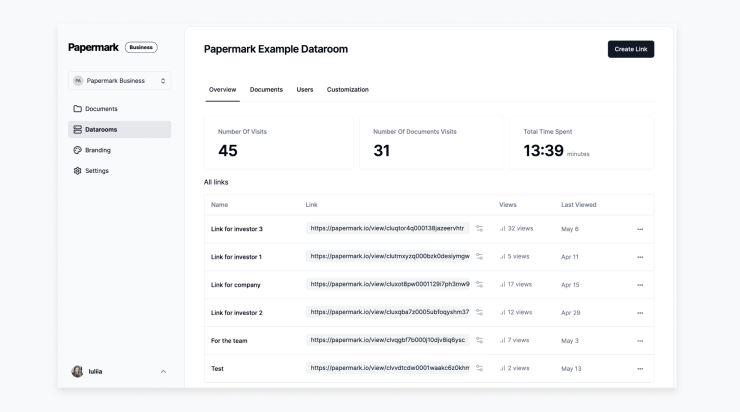
Build an AI Document Management Solution with Us
If you're looking for a partner to help develop an AI document management solution, we’d be happy to help. Our team provides a wide range of custom AI solutions. We'll assist you in selecting the most suitable AI technologies, seamlessly integrating them into your existing tech stack, and delivering a user-ready AI document management solution. Reach out today for a free quote.

Conclusion
AI document management is revolutionizing the way businesses handle their data, offering enhanced efficiency, accuracy, and compliance. By leveraging AI technologies, organizations can automate routine tasks, bring structure to unstructured data, and improve decision-making processes. As the volume of global data continues to grow, investing in AI-powered document management solutions will be essential for maintaining a competitive edge and ensuring optimal productivity.

